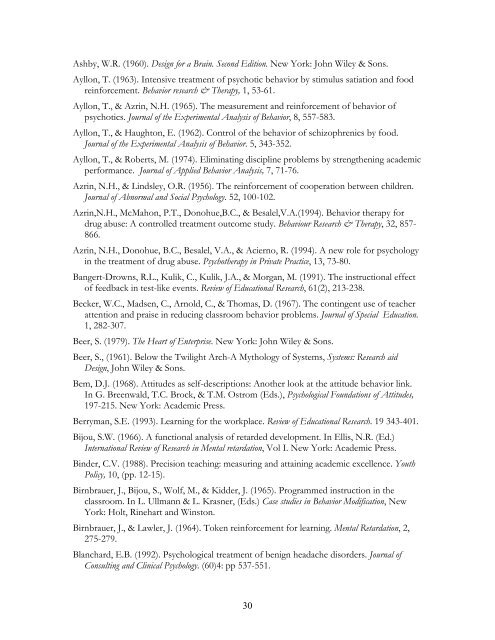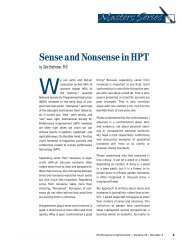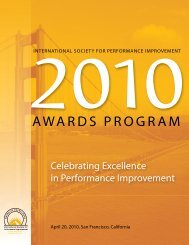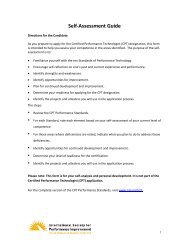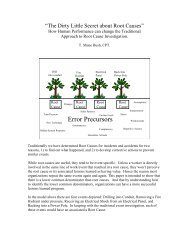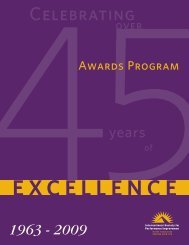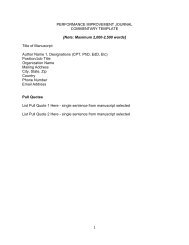Yes We Can! - International Society for Performance Improvement
Yes We Can! - International Society for Performance Improvement
Yes We Can! - International Society for Performance Improvement
You also want an ePaper? Increase the reach of your titles
YUMPU automatically turns print PDFs into web optimized ePapers that Google loves.
Ashby, W.R. (1960). Design <strong>for</strong> a Brain. Second Edition. New York: John Wiley & Sons.<br />
Ayllon, T. (1963). Intensive treatment of psychotic behavior by stimulus satiation and food<br />
rein<strong>for</strong>cement. Behavior research & Therapy, 1, 53-61.<br />
Ayllon, T., & Azrin, N.H. (1965). The measurement and rein<strong>for</strong>cement of behavior of<br />
psychotics. Journal of the Experimental Analysis of Behavior, 8, 557-583.<br />
Ayllon, T., & Haughton, E. (1962). Control of the behavior of schizophrenics by food.<br />
Journal of the Experimental Analysis of Behavior. 5, 343-352.<br />
Ayllon, T., & Roberts, M. (1974). Eliminating discipline problems by strengthening academic<br />
per<strong>for</strong>mance. Journal of Applied Behavior Analysis, 7, 71-76.<br />
Azrin, N.H., & Lindsley, O.R. (1956). The rein<strong>for</strong>cement of cooperation between children.<br />
Journal of Abnormal and Social Psychology. 52, 100-102.<br />
Azrin,N.H., McMahon, P.T., Donohue,B.C., & Besalel,V.A.(1994). Behavior therapy <strong>for</strong><br />
drug abuse: A controlled treatment outcome study. Behaviour Research & Therapy, 32, 857-<br />
866.<br />
Azrin, N.H., Donohue, B.C., Besalel, V.A., & Acierno, R. (1994). A new role <strong>for</strong> psychology<br />
in the treatment of drug abuse. Psychotherapy in Private Practice, 13, 73-80.<br />
Bangert-Drowns, R.L., Kulik, C., Kulik, J.A., & Morgan, M. (1991). The instructional effect<br />
of feedback in test-like events. Review of Educational Research, 61(2), 213-238.<br />
Becker, W.C., Madsen, C., Arnold, C., & Thomas, D. (1967). The contingent use of teacher<br />
attention and praise in reducing classroom behavior problems. Journal of Special Education.<br />
1, 282-307.<br />
Beer, S. (1979). The Heart of Enterprise. New York: John Wiley & Sons.<br />
Beer, S., (1961). Below the Twilight Arch-A Mythology of Systems, Systems: Research aid<br />
Design, John Wiley & Sons.<br />
Bem, D.J. (1968). Attitudes as self-descriptions: Another look at the attitude behavior link.<br />
In G. Breenwald, T.C. Brock, & T.M. Ostrom (Eds.), Psychological Foundations of Attitudes,<br />
197-215. New York: Academic Press.<br />
Berryman, S.E. (1993). Learning <strong>for</strong> the workplace. Review of Educational Research. 19 343-401.<br />
Bijou, S.W. (1966). A functional analysis of retarded development. In Ellis, N.R. (Ed.)<br />
<strong>International</strong> Review of Research in Mental retardation, Vol I. New York: Academic Press.<br />
Binder, C.V. (1988). Precision teaching: measuring and attaining academic excellence. Youth<br />
Policy, 10, (pp. 12-15).<br />
Birnbrauer, J., Bijou, S., Wolf, M., & Kidder, J. (1965). Programmed instruction in the<br />
classroom. In L. Ullmann & L. Krasner, (Eds.) Case studies in Behavior Modification, New<br />
York: Holt, Rinehart and Winston.<br />
Birnbrauer, J., & Lawler, J. (1964). Token rein<strong>for</strong>cement <strong>for</strong> learning. Mental Retardation, 2,<br />
275-279.<br />
Blanchard, E.B. (1992). Psychological treatment of benign headache disorders. Journal of<br />
Consulting and Clinical Psychology. (60)4: pp 537-551.<br />
30


